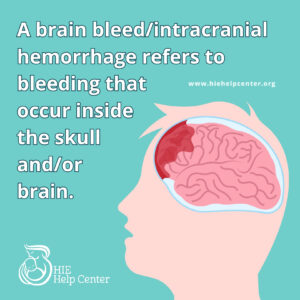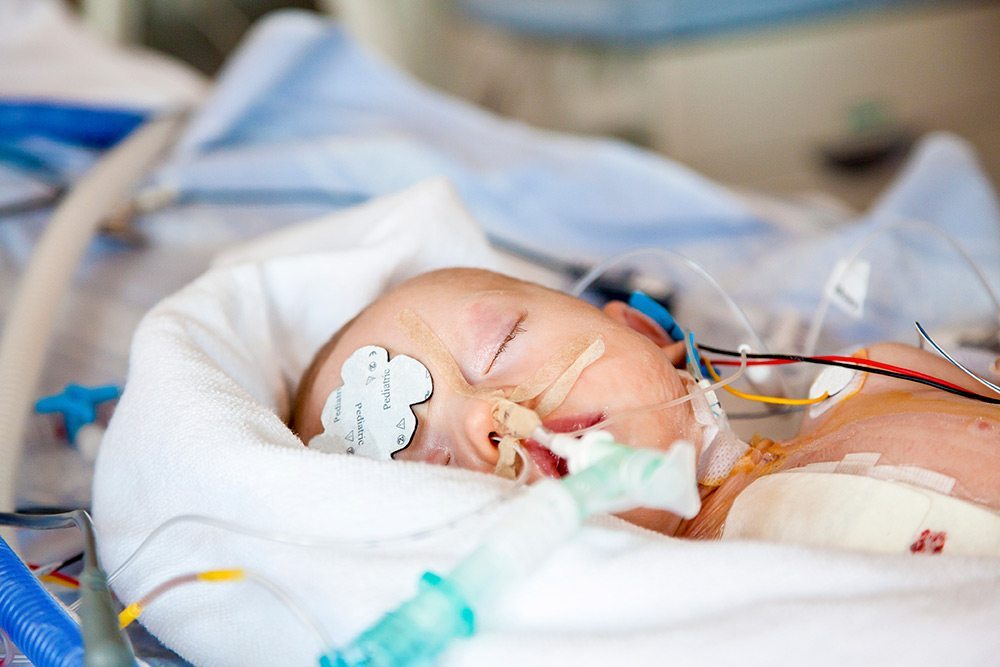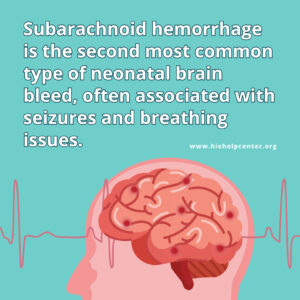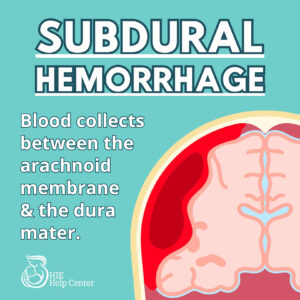 An “intracranial hemorrhage” or “brain bleed” refers to bleeding that occurs inside the skull or brain. Newborns with hypoxic-ischemic encephalopathy (HIE) often also have intracranial hemorrhages. Both are considered birth injuries. Children with HIE and/or intracranial hemorrhages are also at increased risk for permanent disabilities such as cerebral palsy.
An “intracranial hemorrhage” or “brain bleed” refers to bleeding that occurs inside the skull or brain. Newborns with hypoxic-ischemic encephalopathy (HIE) often also have intracranial hemorrhages. Both are considered birth injuries. Children with HIE and/or intracranial hemorrhages are also at increased risk for permanent disabilities such as cerebral palsy.
Types of intracranial hemorrhages
Brain bleeds can be classified based on the location where the bleeding occurs. The location and extent of the bleeding determine what kind of damage the bleeding will cause. The following are some types of intracranial hemorrhages:
Cerebral Hemorrhage
Bleeding within the brain itself; classified as a type of stroke caused by a ruptured blood vessel. May also be called intracerebral hemorrhage (ICH) or hemorrhagic stroke (1).
Subarachnoid hemorrhage
Bleeding between the pia mater (innermost membrane surrounding the brain) and the arachnoid membrane (2). This is the second most common type of neonatal brain bleed, and is often associated with seizures and breathing issues (3).
Intraventricular hemorrhage
Intraventricular hemorrhage involves bleeding into the brain’s ventricles, where spinal fluid is produced. It is most common in premature infants (3).
Subdural hemorrhage
This is the most common type of brain bleed in newborns. In a subdural hemorrhage, blood collects between the arachnoid membrane and the dura mater. This bleeding often causes seizures and respiratory issues. Rarer complications include an enlarged head, bradycardia, and coma.
Signs, diagnosis and treatment of intracranial hemorrhages
The symptoms of a brain bleed can vary, but they overlap with the symptoms of HIE. These symptoms can include the following, among others (2, 3):
- Altered consciousness or coma
- Seizures
- Apnea and breathing issues
- Metabolic problems (e.g. acidosis or an abnormal blood glucose level)
- A bulging soft spot (fontanelle) on the baby’s head
- The baby being too floppy or tense
Brain imaging is absolutely critical for diagnosing an intracranial hemorrhage. If medical staff members suspect that the baby had a brain bleed, they should be doing head imaging studies using a CT scan or MRI. They can also do ultrasound tests and tests of cerebrospinal fluid.
 Treatment for intracranial hemorrhages tends to be supportive (though surgery might be necessary for relieving pressure in some cases). Some babies with brain bleeds recover very well, while those with severe bleeding (and resulting hypoxic-ischemic encephalopathy) may have intellectual or developmental disabilities and/or cerebral palsy (4).
Treatment for intracranial hemorrhages tends to be supportive (though surgery might be necessary for relieving pressure in some cases). Some babies with brain bleeds recover very well, while those with severe bleeding (and resulting hypoxic-ischemic encephalopathy) may have intellectual or developmental disabilities and/or cerebral palsy (4).
Should I contact an attorney?
HIE Help Center is run by ABC Law Centers, a medical malpractice firm exclusively handling cases involving HIE and other birth injuries. Our lawyers have been advocating for children with HIE and related disabilities since the firm’s inception in 1997.
If you suspect your child’s brain bleed may have been caused by medical negligence, please contact us today to learn more about pursuing a case. We provide free legal consultations, during which we will inform you of your legal options and answer any questions you have. Moreover, you would pay nothing throughout the entire legal process unless we obtain a favorable settlement.
You are also welcome to reach out to us with inquiries that are not related to malpractice. We cannot provide individualized medical advice, but we’re happy to track down informational resources for you.
Sources
- Intracerebral Hemorrhage: Symptoms, Causes, and Diagnosis. (2017, May 17). Retrieved April 11, 2024, from https://www.healthline.com/health/lobar-intracerebral-hemorrhage
- Perinatal Intracranial Hemorrhages Pathology. (2022, June 17). Retrieved April 11, 2024, from https://emedicine.medscape.com/article/2059564-overview
- Neonatal Birth Injuries (2023, July 14). Retrieved April 11, 2024, from https://www.uptodate.com/contents/neonatal-birth-injuries
- Infant Intracranial Hemorrhages (Brain Bleeds) | Birth Injuries. (n.d.). Retrieved April 11, 2024, from https://www.abclawcenters.com/practice-areas/prenatal-birth-injuries/traumatic-birth-injuries/intracranial-hemorrhages/



